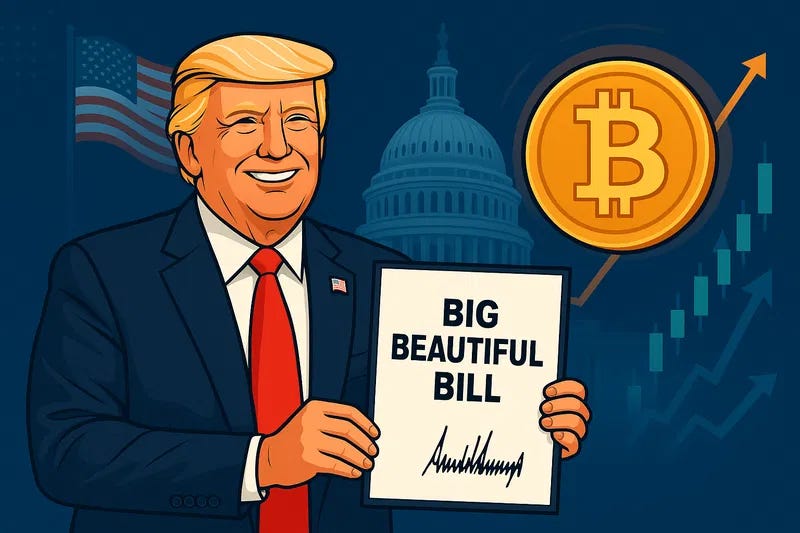
In July 2025, Bitcoin (BTC) shattered previous records, climbing past $120,000 — its highest price in history (so far). This milestone follows months of consolidation between $100,000 and $110,000, with the breakout marking a 15% rise in just two months. The rally has also lifted the broader crypto market, with Ethereum, Solana, and Dogecoin posting significant gains.
As always, naysayers are quick to question the use-case for Bitcoin and point out the volatility of the asset as a flaw. Bitcoiners on the other hand, are jubilant as they watch the value of their holding notch up further gains.
But what are the reasons behind this recent rally? Is it simply a case of ‘number going up’ or are there substantial reasons to explain the gains. And what happens next?
Read on to understand some of the many reasons that could explain this latest shift.
Key Drivers Behind the Rally
1. Pro-Crypto U.S. Policy Shift
The Trump administration has enacted several crypto-friendly policies, including an executive order to establish a U.S. Strategic Reserve of Cryptocurrencies, likened to a “virtual Fort Knox for digital gold”.
This move has legitimized Bitcoin as a sovereign asset and prompted other governments and institutions to follow suit.
Crypto-friendly appointments to regulatory bodies like the CFTC and Office of the Comptroller of the Currency have created a more predictable framework for institutional investors.
2. Institutional Accumulation
Hedge funds, pension managers, and sovereign wealth funds have ramped up their Bitcoin holdings, viewing it as a hedge against fiat currency debasement and macroeconomic instability.
Spot Bitcoin ETFs have seen consistent inflows, with over $770 million added in one week and cumulative net assets surpassing $139 billion.
Exchange flows have dropped to a 10-year low, indicating reduced sell-side pressure and long-term holding behavior. Fewer sellers increases scarcity and pushes up price of any asset, and the same is true for Bitcoin.
3. Macroeconomic Uncertainty
Global trade tensions and tariff announcements have rattled traditional markets, pushing investors toward alternative assets like Bitcoin. The markets now seem somewhat immune or ambivalent towards Trump’s continued threats to apply tariffs, and his tendency to ‘chicken out’ at the last minute seems to have lessened the impacts of recent announcements. Nonetheless, uncertainty appears baked into the global economy.
The U.S. Dollar Index (DXY) has weakened, reinforcing Bitcoin’s appeal as a hedge against inflation and currency volatility. The notable effect of Trump’s first few months in office has been to see the dollar weakened significantly, driving investors towards Bitcoin with ever-more urgency as a possible hedge against dollar devaluation.
Bitcoin’s fixed supply of 21 million coins continues to draw comparisons to gold, with many now viewing it as a superior store of value.

4. Technical Breakout and Market Structure
Bitcoin broke out of a tight consolidation range near $109,000, triggering a surge in buying volume and bullish momentum. Crudely, the sentiment seems to be that people are watching the price go up, panicking that it may continue to do so and are buying more BTC in the hopes of riding the wave. The effect is to push the price up further.
RSI readings above 85 and strong MACD signals suggest robust upward pressure, with traders now eyeing$120,000 as the next milestone. Psychology plays its part and round numbers tend to become new targets for price.
On-chain metrics show reduced Bitcoin supply on exchanges — now at 14.5%, the lowest since 2018 — indicating accumulation and reduced selling pressure. When there is less Bitcoin on exchanges and it has been withdrawn to cold storage, it suggests that holders are intending to keep their BTC squirrelled away and aren’t looking to sell. The scarcity of remaining BTC on exchanges tends to influence the price in an upward direction.
Market Sentiment and Outlook
A recent survey of crypto analysts predicts an average year-end price of $145,167, with long-term projections reaching $458,000 by 2030.
While some experts caution that the rally may be politically inflated or speculative, others argue that Bitcoin is maturing into a macro asset class.
July has historically been a bullish month for Bitcoin, and technical indicators suggest the rally could extendtoward $125,000 if momentum holds.
Risks and Counterpoints
Critics argue that Bitcoin still lacks fundamental utility as a payment system and may be in a speculative bubble. Skeptics have argued pretty much the same since the dawn of Bitcoin, and yet still the adoption of it continues and the price keeps rising.
Profit-taking and macroeconomic shocks — such as regulatory shifts or geopolitical escalations — could trigger short-term volatility. Some analysts also warn that failure to hold support above $107,000 could lead to retracements toward $101,000 or lower. Having experienced more than a few significant drops in price during my time as a Bitcoiner, I both expect and hope for more of the same, as such events represent a great opportunity to buy more BTC at a lower price.
Conclusion
Bitcoin’s ascent to new all-time highs in July 2025 is the result of a confluence of factors: institutional demand, favorable U.S. policy, macroeconomic uncertainty, and technical momentum.
While risks remain, the current rally reflects a broader shift in how Bitcoin is perceived — not just as a speculative asset, but as a legitimate component of global financial infrastructure.
Note: This article is for informational purposes only. It should not be considered Financial or Legal Advice. Consult a financial professional before making any major financial decisions.



